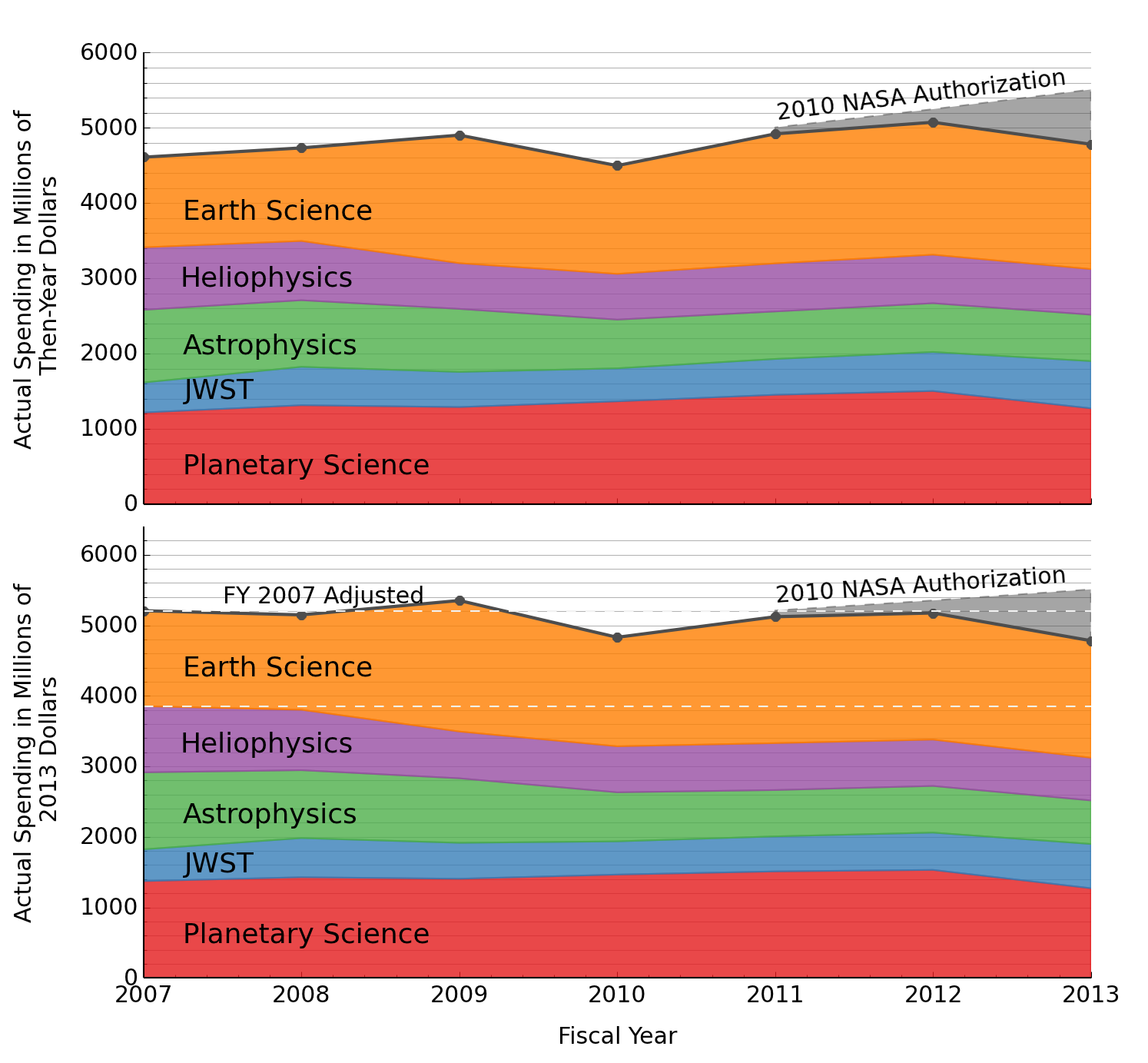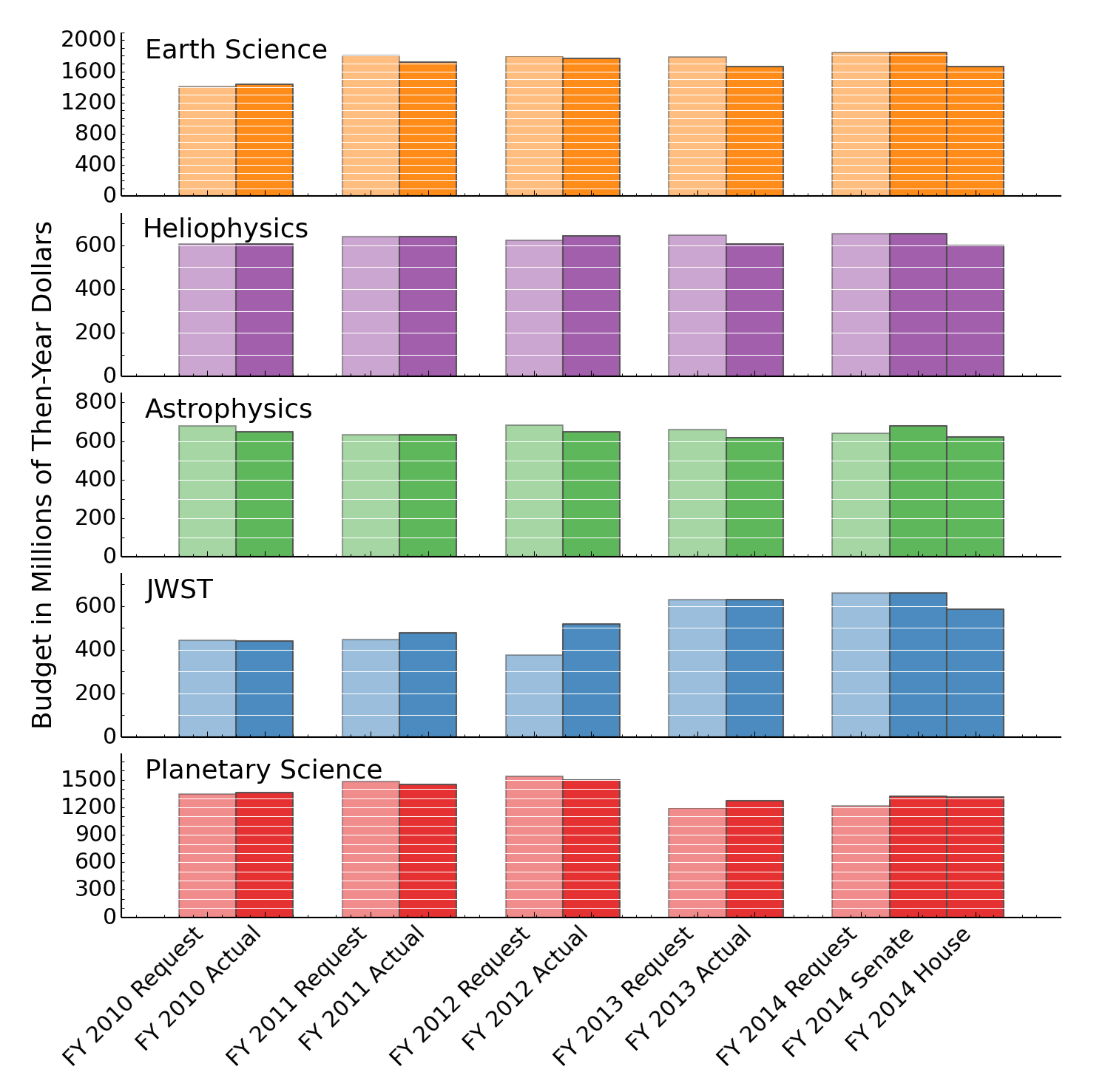More Context, the Broader Picture at NASA's Science Mission Directorate
Josh Shiode
In my last post on the potential NASA Science Mission Directorate (SMD) budget for FY 2014, I left out some context. In particular, there is one division of SMD that does not provide astronomical sciences funding, but factors into the total picture: Earth Science. To provide greater context to our discussion, here are two plots of SMD budgets over time.1
This first plot shows changes in division budgets with time, in then-year dollars on top and fixed 2013 dollars on the bottom2, since FY 2007. Why FY 2007? Before that date, NASA changed its accounting scheme, and the honest truth is I haven't figured out how to reconcile the budgets in a meaningful way. So we'll just pretend that before FY 2007 is irrelevant... Ok? Ok. Next, for clarity, I've separated out the James Webb Space Telescope (JWST) for the full timespan, even though it lived in the Astrophysics division's Cosmic Origins program before FY 2010.

In FY 2009, Earth Science and Astrophysics received $325 million and $75 million, respectively, from the American Recovery and Reinvestment Act of 2009, i.e., the stimulus. As is clear from the plot, the overall NASA SMD budget was growing at about 3% going into the recession, but then dropped sharply in FY 2010 and has yet to recover. Also clear is the Obama Administration's prioritization of Earth Science, which experiences large growth beginning in FY 2009, the first Obama Administration budget. In inflation-adjusted dollars, the budget for the astronomical sciences has been shrinking since FY 2007, slightly faster than the total SMD budget.
While much of the recent focus has been on the very real, large cuts to the Planetary Science division, the rest of the divisions have also been slowly decreasing for several years. In fixed FY 2013 dollars, the SMD budget has declined by $424 million, an 8% cut, between FY 2007 and FY 2013; over the same period, astronomical sciences funding has fallen $730 million, a 19% cut! (Incidentally, this is about the same as the total SMD shortfall compared to the NASA Authorization Act of 2010.) This speaks to one of the most pressing issues for our community: we must speak up together with one loud voice.
The above plot shows each year's actual, enacted budgets, which reflect the sum total of the Administration's priorities, Congressional input and agency decisions. To further highlight how the Administration's priorities factor in, this next plot shows side-by-side comparisons of the President's budget request and the enacted budgets (or appropriations bill language for FY 2014) beginning with FY 2010. Colors are the same in this plot as for the previous, and in each panel, the horizontal lines occur every $100 million then-year dollars.

This plot highlights the sharp cut to Planetary Science proposed in the FY 2013 and FY 2014 budgets as compared to previously strong support. This cut was opposed by Congress, resulting in an enacted cut about $100M smaller than proposed. Also clear is the rebaselining of JWST, which occured in mid-2011 as appropriations were being debated for FY 2012.
Hopefully, this has helped clear up some open questions from the previous post, but if anything remains unclear, please let me know! I'm hoping to continue using this space to share all that I'm learning as I make my transition from astrophysics researcher to science policy wonk. Next up, we'll take a look at the NSF budgets!
1My goal is to learn how to set up interactive plotting for all the relevant budgets on the AAS site. In the meantime, if you have suggestions for better ways to display this information, I'm all ears! And would happily provide you the data tables I've used to make them.
2Inflation adjustment using Consumer Price Index (CPI) data from the Bureau of Labor Statistics.

